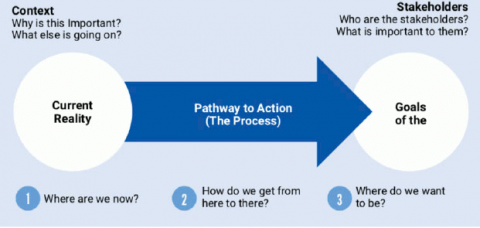
Part 1: Get Ready
2. Build Your Team And Map Out Your Process
You’re embarking on a change and it’s something you can’t facilitate on your own. You’ll need a Race, Equity and Inclusion Strategy Team to help you assess where your United Way is on its race, equity and inclusion journey; articulate what you hope to accomplish; design the process; and plan the changes and activities necessary to get you there .
You may also need support from capacity builders (facilitators, trainers, or consultants) to design and implement parts of your process. This early stage is all about assessing your United Way’s readiness to explicitly focus on race, equity and inclusion. The collaborative process will include a combination of learning, planning, coaching and other activities that lead to a plan. This won’t be your only assessment, just an important first step.
In This Section, We’ll Explore How To
- Pull Together Your Race, Equity And Inclusion Strategy Team
- Identify External Resources, Assess Readiness And Explore Stakeholder Interests
- Focus On The Wheel Of Change And Design Your Pathway To Action.
Although the guidance and tools in this section focus on your internal organization, they can also be useful to support community impact planning.
Pull Together Your Race, Equity And Inclusion Strategy Team
You need a group to think through how to lead this change. We recommend that you assemble a Race, Equity and Inclusion (REI) Strategy Team that includes people from different organizational roles, racial/ethnic backgrounds, generations and genders. They could be all-volunteer or a combination of stakeholders who volunteer and stakeholders whom you recruit based on their experience with race, equity and inclusion work. Stakeholders on a Race, Equity and Inclusion Strategy team may include staff, program participants, community members and/or board members.
At this stage, look for innovators and early adopters who are already working on these issues and willing enthusiasts who may not be in motion yet. You’ll need a combination of experience and “beginner’s mind” to design a process that works for everyone. They should work with you to map out and guide your change process every step of the way
Begin by building community—share stories of your identities and interest in the topic. Then work to develop shared language and understanding of the team’s role. Be sure to explore the Case for Change and Big Picture with the team, refining as needed based on their input.
Identify External Resources
As a leader, you’re likely to learn that you can move many parts of the work forward on your own in partnership with the Race, Equity and Inclusion Strategy Team. Your collaboration may also value advice and guidance from external parties. Here are a few questions to ask yourself as you begin your work:
What is my level of knowledge, comfort and skill in:
- Discussing issues related to race, equity and inclusion
- Facilitating discussions about race, equity and inclusion
- Designing collaborative planning or organizational change processes
What skills and experience do Race, Equity and Inclusion Strategy Team members have in:
- Discussing issues related to race, equity and inclusion
- Facilitating discussions about race, equity and inclusion
- Designing collaborative planning or organizational change processes
Among our community partner organizations, who is a step or two ahead of us in their focus on race,
equity and inclusion? What could we learn from them?
Who has supported them in their work? How could we work together (e.g., co-sponsor a workshop)?
Do we have a community advisory group or other ongoing way to engage with our program
participants?
How could we tap into their expertise?
Who else could support some of our efforts to prepare for a more explicit focus on race, equity
and inclusion?
Which local researchers, trainers, facilitators, organizers, or organizational change consultants could we tap?
Assess Readiness And Explore Stakeholder Interests
To design a planning and learning process that will inspire people and create positive change, think systematically about your stakeholders: what’s important to them; how issues of race, equity and inclusion affect them; and how ready your United Way and community are to explicitly address race, equity and inclusion. You want to identify early adopters and others who will enthusiastically champion the focus on race, equity and inclusion.
On the other side of the spectrum, you’ll also want to identify possible opponents and sources of resistance to develop strategies for addressing them. In this stage, you’ll want to engage with some of your stakeholders to pressure-test the team’s thinking through oneon-one conversations, small group discussions, focus groups, or surveys.
Focus On “The Wheel Of Change”
As in all organizational development work, making and sustaining change related to race, equity and inclusion overlaps in three arenas:
- Organizational structures and policies–how they either support or impede your race, equity and inclusion goals
- Hearts and minds — the individual and organizational focus on values, knowledge, beliefs and commitment
- Behaviors and practices — how individuals and organizational culture change with new policies and practices
The history of work focused on race, equity and inclusion is full of debates about the “right way” to actualize our visions. In fact, there’s no single “right” strategy. If we engage hearts and minds but don’t focus on structures or behaviors, people will likely continue to operate in the same ways as always. If we only focus on changing structures, people won’t understand or be committed to the change and continue to practice business as usual, even within new structures.
Focusing on individual behavioral change is important, but it won’t stick without also engaging hearts and minds and it won’t add up to the change you seek if there are no structural shifts to support new behaviors. So it’s important to pull from each of these strategies. Before your Race, Equity and Inclusion Strategy Team begins to map out your process, consider how you can engage all three domains of the Wheel of Change.
Design Your Pathway To Action © Interaction Institute for Social Change, Reprinted with permission. May be used and reproduced by local United Ways for non-commercial use with attribution.
Once you have a strong sense of your stakeholders’ interests and needs—and a good idea of how to balance your focus on hearts and minds, structures and behaviors— it’s time to map out your Pathway to Action. This is a combination of planning and learning activities that will build shared language and a practical plan.
Think through the outcomes (e.g., shared understandings or agreements), products (e.g., vision and action plans), or other milestones you want to achieve during your learning and planning process.
You and the Race, Equity and Inclusion Strategy Team should establish a logic or flow of topics. This could include:
- Learning/building a shared understanding of racial discrimination
- Naming and healing from past harms caused by racism within your United Way
- Agreeing on a vision of what racial equity will look like in our community
- Diving into how opportunities and challenges related to race, equity and inclusion have shown up historically, and how they currently manifest in your community and your United Way
- Identifying strategies to pursue equity and inclusion within your United Way and within your community.
- Developing a plan of action.
Think about the kinds of teams you’ll need to move through your process. For some, the Race, Equity and Inclusion Strategy Team may be the only team that you need. Once they’ve designed the process, they can take on the role of developing the plan with input from your stakeholders. You also may need to set up short-term working groups or task teams focused on a specific topic (e.g., housing, employment) or activity (e.g., communications). No matter what kinds of teams you create, be clear about who will make final decisions about the plan of action and who you need to engage for input and feedback along the way.
Then you’re ready to think about concrete learning and planning activities. A typical process will involve some combination of the following:
Dialogue, Healing, Or Team Building
Teams need time and space to learn about members’ personal experiences with race, equity and inclusion. This is an opportunity not only to share about one another’s backgrounds, but also to unpack difficult situations or repair harms that may have happened within your United Way. Often this kind of dialogue is important before diving into initial learning or planning and revisiting them later in the process.
Learning
This could include workshops focused on race, equity and inclusion content and concepts. It could also include workshops focused on collaboration, facilitation, or community-organizing practices to support race, equity and inclusion efforts. (See Tools section for Learning Resources.)
Planning
Topics could include developing a shared understanding of problems and issues, a shared vision of a better future, a plan of action and ways to monitor implementation and assess impact. The “Seven Steps to Embrace Race Equity in Part Two of This Practice Guide” provides a useful framework for planning focused on specific areas of impact.
Affinity Groups
Individuals often need ongoing support to grapple with how racism affects their lives and work. Affinity groups or caucuses are a way for people to explore issues in same-race spaces.
Coaching
One-on-one coaching is often particularly useful for people in leadership and management roles who may be struggling with how to understand their impact and practice more equitable leadership.
Don’t be surprised if it takes you several months to get to this stage. The timeline for the learning and planning process itself may be a shock. It’s common for folks to anticipate a three to six month process, then discover that they need much more time to learn together and engage stakeholders effectively. As you wrestle with the calendar, remember this African proverb: “If you want to go fast, go alone. If you want to go far, go together.”
It may take you longer to create your plan with a high level of stakeholder engagement than it would if a small team from your staff cooked up a plan on its own. However, you’d then spend a long time “selling” the plan to everyone who needs to take part in implementing it. This way, various stakeholders contribute to the thinking and planning to build a constituency for the plan and increase the odds that it will be implemented. In addition, you’re actually doing race, equity and inclusion work at every stage, strengthening the muscles and building organizational readiness.
You also may want to create a simple visual map to summarize the different activities in your pathway and identify facilitators outside of your team to support them.
Related Tools






